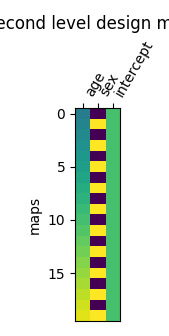Note
Click here to download the full example code or to run this example in your browser via Binder
Example of second level design matrix#
This example shows how a second-level design matrix is specified: assuming that the data refer to a group of individuals, with one image per subject, the design matrix typically holds the characteristics of each individual.
This is used in a second-level analysis to assess the impact of these characteristics on brain signals.
This example requires matplotlib.
try:
import matplotlib.pyplot as plt
except ImportError:
raise RuntimeError("This script needs the matplotlib library")
Create a simple experimental paradigm#
We want to get the group result of a contrast for 20 subjects.
n_subjects = 20
subjects_label = ['sub-%02d' % i for i in range(1, n_subjects + 1)]
Next, we specify extra information about the subjects to create confounders. Without confounders the design matrix would correspond to a one sample test.
import pandas as pd
extra_info_subjects = pd.DataFrame({'subject_label': subjects_label,
'age': range(15, 15 + n_subjects),
'sex': [0, 1] * int(n_subjects / 2)})
Create a second level design matrix#
With that information we can create the second level design matrix.
from nilearn.glm.second_level import make_second_level_design_matrix
design_matrix = make_second_level_design_matrix(subjects_label,
extra_info_subjects)
/home/alexis/miniconda3/envs/nilearn/lib/python3.10/site-packages/nilearn/glm/first_level/design_matrix.py:475: UserWarning:
Attention: Design matrix is singular. Aberrant estimates are expected.
Let’s plot it.
from nilearn.plotting import plot_design_matrix
ax = plot_design_matrix(design_matrix)
ax.set_title('Second level design matrix', fontsize=12)
ax.set_ylabel('maps')
plt.tight_layout()
plt.show()

Total running time of the script: ( 0 minutes 1.508 seconds)
Estimated memory usage: 9 MB